对哈姆雷特独白的分析教学提纲
- 格式:doc
- 大小:24.00 KB
- 文档页数:3
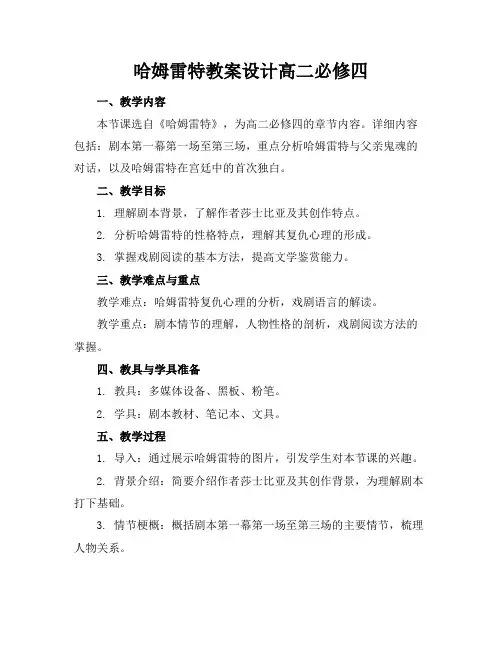
哈姆雷特教案设计高二必修四一、教学内容本节课选自《哈姆雷特》,为高二必修四的章节内容。
详细内容包括:剧本第一幕第一场至第三场,重点分析哈姆雷特与父亲鬼魂的对话,以及哈姆雷特在宫廷中的首次独白。
二、教学目标1. 理解剧本背景,了解作者莎士比亚及其创作特点。
2. 分析哈姆雷特的性格特点,理解其复仇心理的形成。
3. 掌握戏剧阅读的基本方法,提高文学鉴赏能力。
三、教学难点与重点教学难点:哈姆雷特复仇心理的分析,戏剧语言的解读。
教学重点:剧本情节的理解,人物性格的剖析,戏剧阅读方法的掌握。
四、教具与学具准备1. 教具:多媒体设备、黑板、粉笔。
2. 学具:剧本教材、笔记本、文具。
五、教学过程1. 导入:通过展示哈姆雷特的图片,引发学生对本节课的兴趣。
2. 背景介绍:简要介绍作者莎士比亚及其创作背景,为理解剧本打下基础。
3. 情节梗概:概括剧本第一幕第一场至第三场的主要情节,梳理人物关系。
4. 例题讲解:分析哈姆雷特与父亲鬼魂的对话,讲解戏剧语言的含义和作用。
5. 随堂练习:让学生模拟哈姆雷特与父亲鬼魂的对话,体会人物情感。
6. 独白分析:讲解哈姆雷特在宫廷中的首次独白,剖析其性格特点。
7. 小组讨论:分组讨论哈姆雷特的复仇心理,引导学生深入理解人物。
六、板书设计1. 剧本名称:《哈姆雷特》2. 人物关系图:哈姆雷特、父亲鬼魂、母亲、叔叔等3. 剧情概括:第一幕第一场至第三场4. 重点句子:哈姆雷特的独白、与父亲鬼魂的对话七、作业设计1. 作业题目:分析哈姆雷特的复仇心理,结合剧本具体情节进行论述。
答案示例:哈姆雷特的复仇心理源于对父亲鬼魂的信任和对叔叔克劳狄斯的仇恨。
在剧本中,哈姆雷特在与父亲鬼魂的对话中得知真相,决心为父报仇。
然而,他内心矛盾重重,既想复仇,又担忧母亲受到伤害。
这种复杂的心理状态在哈姆雷特的独白中得到了充分体现。
2. 作业要求:不少于600字,要求观点明确,论述清晰。
八、课后反思及拓展延伸1. 反思:本节课的教学过程中,要注意关注学生的学习反馈,及时调整教学节奏和难度。
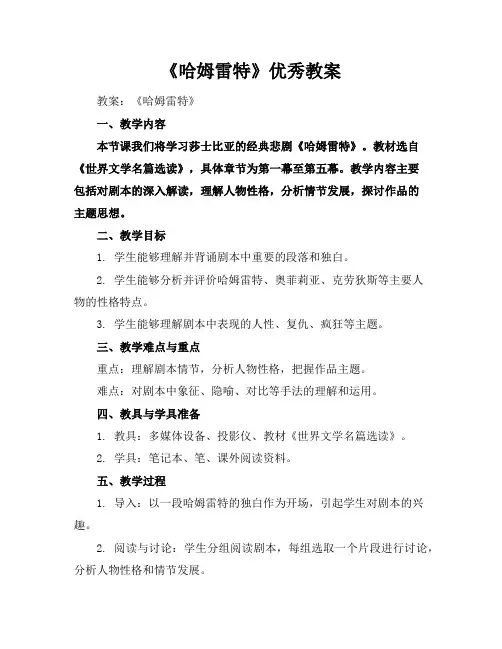
《哈姆雷特》优秀教案教案:《哈姆雷特》一、教学内容本节课我们将学习莎士比亚的经典悲剧《哈姆雷特》。
教材选自《世界文学名篇选读》,具体章节为第一幕至第五幕。
教学内容主要包括对剧本的深入解读,理解人物性格,分析情节发展,探讨作品的主题思想。
二、教学目标1. 学生能够理解并背诵剧本中重要的段落和独白。
2. 学生能够分析并评价哈姆雷特、奥菲莉亚、克劳狄斯等主要人物的性格特点。
3. 学生能够理解剧本中表现的人性、复仇、疯狂等主题。
三、教学难点与重点重点:理解剧本情节,分析人物性格,把握作品主题。
难点:对剧本中象征、隐喻、对比等手法的理解和运用。
四、教具与学具准备1. 教具:多媒体设备、投影仪、教材《世界文学名篇选读》。
2. 学具:笔记本、笔、课外阅读资料。
五、教学过程1. 导入:以一段哈姆雷特的独白作为开场,引起学生对剧本的兴趣。
2. 阅读与讨论:学生分组阅读剧本,每组选取一个片段进行讨论,分析人物性格和情节发展。
3. 分析与解读:教师引导学生对重要情节和人物进行分析,解读剧本中的象征、隐喻、对比等手法。
4. 角色扮演:学生分组进行角色扮演,深入体验人物情感,理解剧本内涵。
六、板书设计板书内容主要包括:剧本情节概括、人物关系图、主题思想探讨。
七、作业设计1. 作业题目:请结合剧本内容,分析哈姆雷特的性格特点,并谈谈你对他的看法。
2. 作业答案:哈姆雷特性格矛盾复杂,他既有复仇的决心,又对人生充满疑惑。
他具有敏锐的洞察力,又深受疯狂的困扰。
他是一个充满悲剧色彩的人物。
八、课后反思及拓展延伸课后,教师应反思本次教学的效果,针对学生的反馈进行调整。
同时,可以推荐学生阅读其他关于《哈姆雷特》的评论和研究,拓展对剧本的理解和分析。
还可以组织学生进行剧本改编或表演,加深对作品的理解和感悟。
重点和难点解析一、教学内容细节重点关注(1)教材章节:本节课学习的教材章节为《世界文学名篇选读》中关于《哈姆雷特》的第一幕至第五幕。

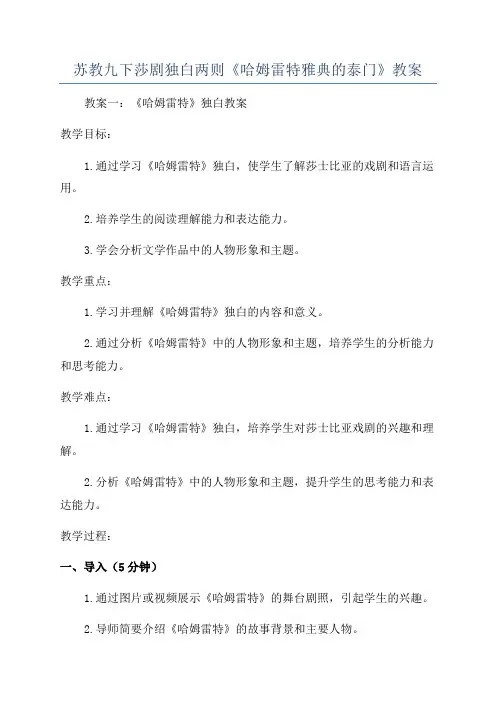
苏教九下莎剧独白两则《哈姆雷特雅典的泰门》教案教案一:《哈姆雷特》独白教案教学目标:1.通过学习《哈姆雷特》独白,使学生了解莎士比亚的戏剧和语言运用。
2.培养学生的阅读理解能力和表达能力。
3.学会分析文学作品中的人物形象和主题。
教学重点:1.学习并理解《哈姆雷特》独白的内容和意义。
2.通过分析《哈姆雷特》中的人物形象和主题,培养学生的分析能力和思考能力。
教学难点:1.通过学习《哈姆雷特》独白,培养学生对莎士比亚戏剧的兴趣和理解。
2.分析《哈姆雷特》中的人物形象和主题,提升学生的思考能力和表达能力。
教学过程:一、导入(5分钟)1.通过图片或视频展示《哈姆雷特》的舞台剧照,引起学生的兴趣。
2.导师简要介绍《哈姆雷特》的故事背景和主要人物。
二、阅读和理解(15分钟)1.学生阅读《哈姆雷特》独白,并在读后回答相关问题。
2.分组讨论学生的理解和感受,并分享自己的观点。
三、分析人物形象和主题(20分钟)1.引导学生分析并讨论《哈姆雷特》中的主要人物形象,如哈姆雷特、克劳狄斯、奥菲利亚等。
2.引导学生分析并讨论《哈姆雷特》中的主要主题,如思维与行动、道德与伦理等。
四、展示和讨论(20分钟)1.学生分组展示他们对《哈姆雷特》的理解和分析,可以选择表演独白或是分享自己的观点。
2.全班讨论学生的展示和表达,并加以评价和补充。
五、总结和拓展(10分钟)1.教师总结本课内容和学生的提问。
2.提供课外阅读推荐,鼓励学生拓展对莎士比亚和《哈姆雷特》的了解。
教学延伸:1.学生可以尝试阅读全本《哈姆雷特》,并与独白进行比较。
2.学生可以尝试观看《哈姆雷特》的电影或舞台剧,加深对莎士比亚戏剧的理解。
教案二:《雅典的泰门》独白教案教学目标:1.通过学习《雅典的泰门》独白,使学生了解莎士比亚的喜剧和人性思考。
2.培养学生的阅读理解能力和表达能力。
3.学会分析文学作品中的人物形象和主题。
教学重点:1.学习并理解《雅典的泰门》独白的内容和意义。
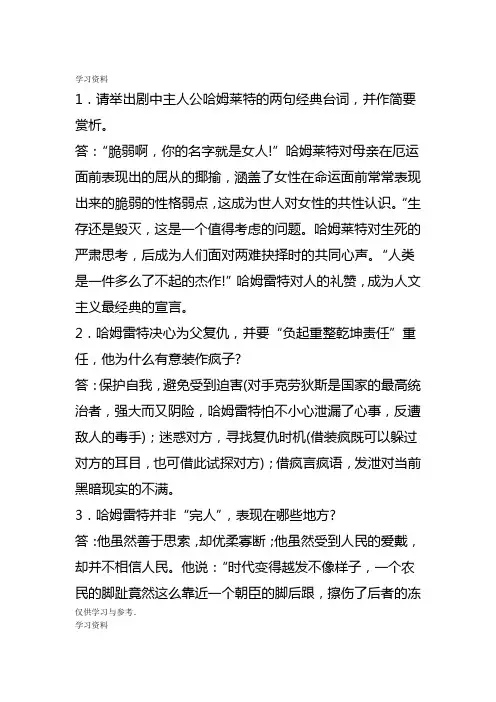
学习资料1.请举出剧中主人公哈姆莱特的两句经典台词,并作简要赏析。
答:“脆弱啊,你的名字就是女人!”哈姆莱特对母亲在厄运面前表现出的屈从的揶揄,涵盖了女性在命运面前常常表现出来的脆弱的性格弱点,这成为世人对女性的共性认识。
“生存还是毁灭,这是一个值得考虑的问题。
哈姆莱特对生死的严肃思考,后成为人们面对两难抉择时的共同心声。
“人类是一件多么了不起的杰作!”哈姆雷特对人的礼赞,成为人文主义最经典的宣言。
2.哈姆雷特决心为父复仇,并要“负起重整乾坤责任”重任,他为什么有意装作疯子?答:保护自我,避免受到迫害(对手克劳狄斯是国家的最高统治者,强大而又阴险,哈姆雷特怕不小心泄漏了心事,反遭敌人的毒手);迷惑对方,寻找复仇时机(借装疯既可以躲过对方的耳目,也可借此试探对方);借疯言疯语,发泄对当前黑暗现实的不满。
3.哈姆雷特并非“完人”,表现在哪些地方?答:他虽然善于思索,却优柔寡断;他虽然受到人民的爱戴,却并不相信人民。
他说:“时代变得越发不像样子,一个农民的脚趾竟然这么靠近一个朝臣的脚后跟,擦伤了后者的冻仅供学习与参考.学习资料疮。
”可见哈姆雷特的社会改革与农民所要求的变革相距甚远。
尽管哈姆雷特有令人钦佩的才能,竭力想除旧布新,但他总是郁郁不乐,迟疑不决,他始终是孤立的。
这就注定了他与丑恶同归于尽的悲惨命运。
4.简析《哈姆雷特》中主要的戏剧冲突及其意义。
答:《哈姆雷特》中主要的戏剧冲突是哈姆雷特与克劳狄斯、王后的冲突,这一冲突深刻地反映了先进的人文主义理想与英国黑暗现实之间的不可调和的矛盾。
5.请简要分析莎士比亚《哈姆雷特》中主人公哈姆雷特的主要性格特征。
答:哈姆雷特是一个人文主义知识分子的典型,在为父报仇过程中优柔寡断,由于复仇任务的艰巨和自身力量的不足,同时出于道德、爱情的种种思考,他找不到复仇和变革的途径,这使得他长于思考,行动迟缓。
6.克劳狄斯谋杀老国王之后,还写了四重误杀。
清说出是哪四重?答:四重误杀是:哈姆雷特误杀波洛涅斯、英国国王误杀克劳迪斯的两位使者、克劳迪斯误杀王后葛露特、哈姆雷特误仅供学习与参考.学习资料杀雷欧提斯。
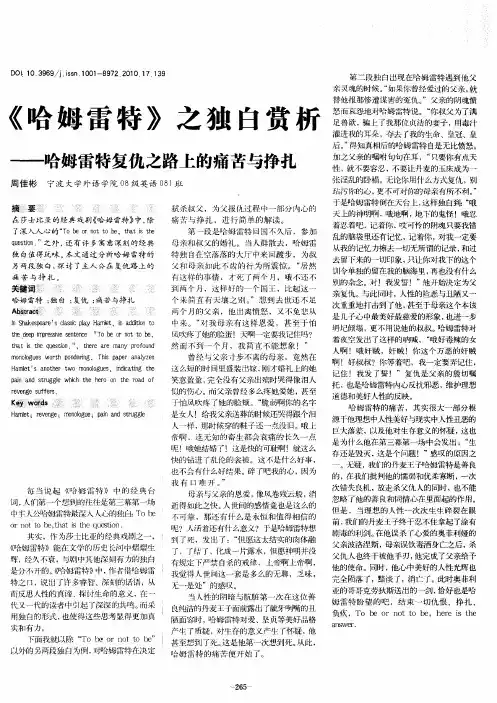
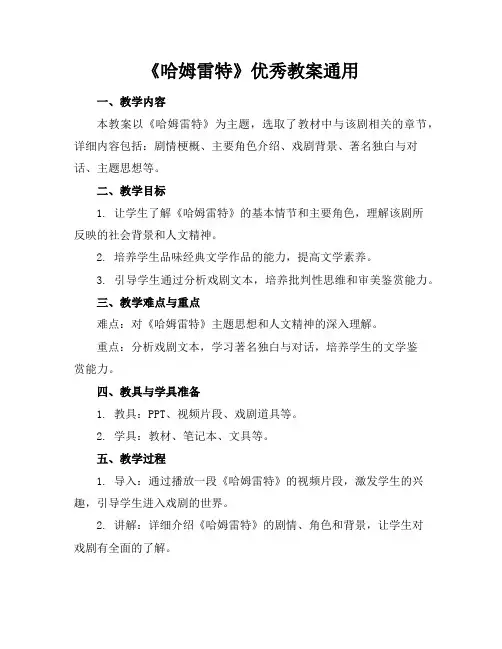
《哈姆雷特》优秀教案通用一、教学内容本教案以《哈姆雷特》为主题,选取了教材中与该剧相关的章节,详细内容包括:剧情梗概、主要角色介绍、戏剧背景、著名独白与对话、主题思想等。
二、教学目标1. 让学生了解《哈姆雷特》的基本情节和主要角色,理解该剧所反映的社会背景和人文精神。
2. 培养学生品味经典文学作品的能力,提高文学素养。
3. 引导学生通过分析戏剧文本,培养批判性思维和审美鉴赏能力。
三、教学难点与重点难点:对《哈姆雷特》主题思想和人文精神的深入理解。
重点:分析戏剧文本,学习著名独白与对话,培养学生的文学鉴赏能力。
四、教具与学具准备1. 教具:PPT、视频片段、戏剧道具等。
2. 学具:教材、笔记本、文具等。
五、教学过程1. 导入:通过播放一段《哈姆雷特》的视频片段,激发学生的兴趣,引导学生进入戏剧的世界。
2. 讲解:详细介绍《哈姆雷特》的剧情、角色和背景,让学生对戏剧有全面的了解。
3. 分析:选取著名独白与对话,进行文本分析,让学生感受戏剧的语言魅力。
4. 随堂练习:让学生分组讨论,分析戏剧中的某一角色或情节,并进行分享。
5. 作业布置:设计相关作业,巩固所学内容。
六、板书设计1. 剧情梗概2. 主要角色3. 社会背景4. 著名独白与对话5. 主题思想七、作业设计1. 作业题目:分析《哈姆雷特》中哈姆雷特与奥菲莉亚的爱情悲剧,谈谈你的看法。
答案示例:哈姆雷特与奥菲莉亚的爱情悲剧源于社会环境和家庭背景的冲突,表现了人性的挣扎和无奈。
2. 作业题目:以《哈姆雷特》为例,谈谈你对悲剧的理解。
答案示例:悲剧是一种表现人生苦难、冲突和毁灭的艺术形式,通过悲剧,人们可以反思生活、认识自我,达到心灵的升华。
八、课后反思及拓展延伸1. 课后反思:本节课结束后,教师应反思教学过程中的优点和不足,以便不断提高教学质量。
2. 拓展延伸:鼓励学生阅读莎士比亚的其他作品,了解英国文艺复兴时期的戏剧艺术,提高文学素养。
重点和难点解析1. 教学目标中的培养学生品味经典文学作品的能力。
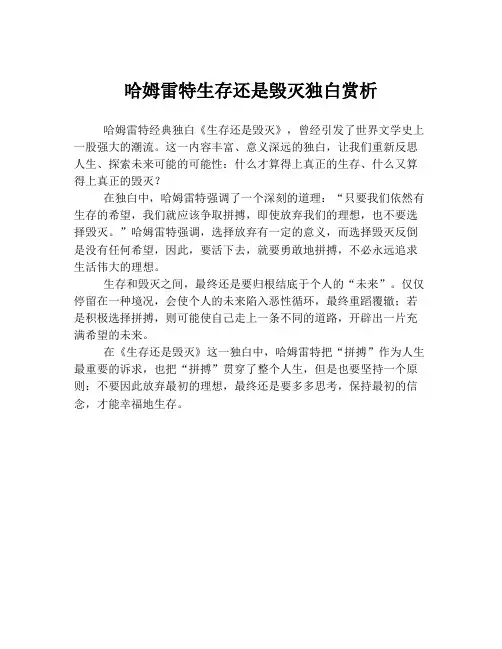
哈姆雷特生存还是毁灭独白赏析
哈姆雷特经典独白《生存还是毁灭》,曾经引发了世界文学史上一股强大的潮流。
这一内容丰富、意义深远的独白,让我们重新反思人生、探索未来可能的可能性:什么才算得上真正的生存、什么又算得上真正的毁灭?
在独白中,哈姆雷特强调了一个深刻的道理:“只要我们依然有生存的希望,我们就应该争取拼搏,即使放弃我们的理想,也不要选择毁灭。
”哈姆雷特强调,选择放弃有一定的意义,而选择毁灭反倒是没有任何希望,因此,要活下去,就要勇敢地拼搏,不必永远追求生活伟大的理想。
生存和毁灭之间,最终还是要归根结底于个人的“未来”。
仅仅停留在一种境况,会使个人的未来陷入恶性循环,最终重蹈覆辙;若是积极选择拼搏,则可能使自己走上一条不同的道路,开辟出一片充满希望的未来。
在《生存还是毁灭》这一独白中,哈姆雷特把“拼搏”作为人生最重要的诉求,也把“拼搏”贯穿了整个人生,但是也要坚持一个原则:不要因此放弃最初的理想,最终还是要多多思考,保持最初的信念,才能幸福地生存。
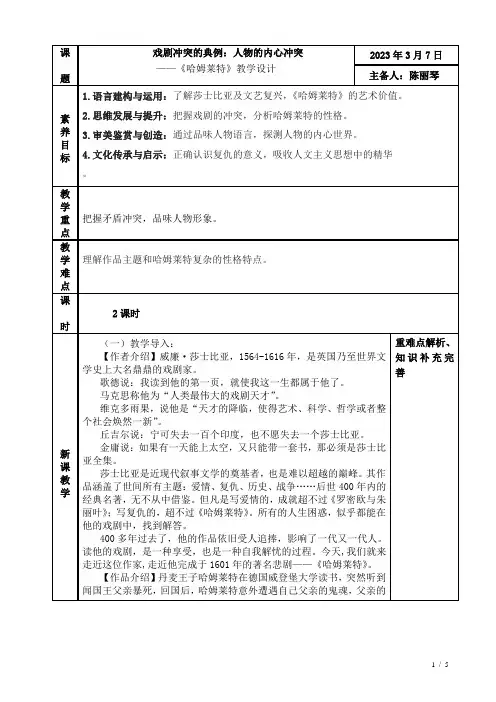
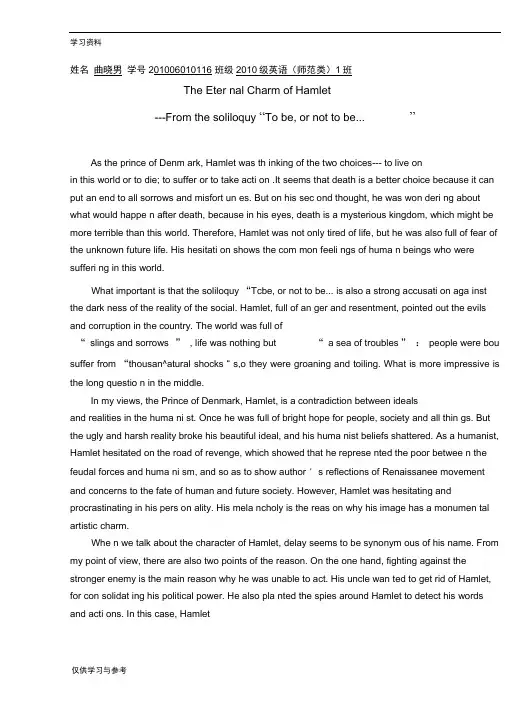
姓名曲晓男学号201006010116 班级2010级英语(师范类)1班The Eter nal Charm of Hamlet---From the soliloquy “To be, or not to be... ”As the prince of Denm ark, Hamlet was th inking of the two choices--- to live onin this world or to die; to suffer or to take acti on .It seems that death is a better choice because it can put an end to all sorrows and misfort un es. But on his sec ond thought, he was won deri ng about what would happe n after death, because in his eyes, death is a mysterious kingdom, which might be more terrible than this world. Therefore, Hamlet was not only tired of life, but he was also full of fear of the unknown future life. His hesitati on shows the com mon feeli ngs of huma n beings who were sufferi ng in this world.What important is that the soliloquy “Tcbe, or not to be... is also a strong accusati on aga inst the dark ness of the reality of the social. Hamlet, full of an ger and resentment, pointed out the evils and corruption in the country. The world was full of“ slings and sorrows ” , life was nothing but “ a sea of troubles ” : people were bou suffer from “thousan^atural shocks ” s,o they were groaning and toiling. What is more impressive is the long questio n in the middle.In my views, the Prince of Denmark, Hamlet, is a contradiction between idealsand realities in the huma ni st. Once he was full of bright hope for people, society and all thin gs. But the ugly and harsh reality broke his beautiful ideal, and his huma nist beliefs shattered. As a humanist, Hamlet hesitated on the road of revenge, which showed that he represe nted the poor betwee n the feudal forces and huma ni sm, and so as to show author ' s reflections of Renaissanee movement and concerns to the fate of human and future society. However, Hamlet was hesitating and procrastinating in his pers on ality. His mela ncholy is the reas on why his image has a monumen tal artistic charm.Whe n we talk about the character of Hamlet, delay seems to be synonym ous of his name. From my point of view, there are also two points of the reason. On the one hand, fighting against the stronger enemy is the main reason why he was unable to act. His uncle wan ted to get rid of Hamlet, for con solidat ing his political power. He also pla nted the spies around Hamlet to detect his words and acti ons. In this case, Hamlethad to postpone his revenge plan and his hesitation was showed. On the other hand, Hamlet knewthe difficult task of his revenge. He not only wanted to revenge for his father, but also wanted to reverse the tide. Faced with these dual tasks, he wanted to take action but did not know how to act. In the play, the heart of the contradiction had driven the character of Hamlet to perform the delay and hesitation vividly。
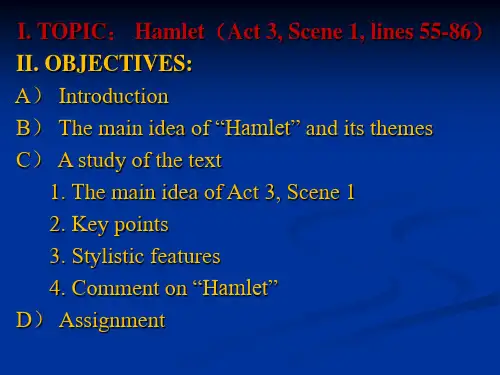
人教版高一语文哈姆莱特莎士比亚教案提纲人教版高一语文《哈姆莱特》莎士比亚教案提纲一、教材分析1. 《哈姆莱特》是人教版高一语文必修一的经典文学作品之一,具有很高的文学和艺术价值。
2. 《哈姆莱特》讲述了丹麦王国的王储哈姆莱特为父亲的冤案展开调查,最终在复仇中殒命的故事。
3. 教学目标:通过学习《哈姆莱特》,达到以下几个方面的培养:(1)培养学生对文学作品的理解能力和文学鉴赏水平。
(2)培养学生的阅读能力和批判思维能力。
(3)使学生感受到文学艺术的魅力,提升其语文素养。
4. 教学难点:《哈姆莱特》的文学价值和艺术魅力的理解和领悟。
二、教学重点1. 哈姆莱特心理变化的描写和其决定行动的关键时刻。
2. 剧中人物关系的理解和分析。
3. 批判思维、文学鉴赏与创造性思维。
三、教学方法1. 课堂讲授与讨论相结合,注重学生自主学习思考。
2. 辅助材料与实践应用相结合,引导学生更好地理解和应用。
3. 个性化教学与合作学习相结合,充分发挥学生的自主性和团队合作精神。
四、教学内容及时间分配第一讲掌握剧本,理解基本情节(2课时)1. 介绍《哈姆莱特》的作者和背景,引发学生兴趣。
2. 基本情节的整理和讲解,引导学生初步了解故事背景和主要角色。
3. 剧本朗读和场景分析,对话练习和小组讨论(批判思维的运用)。
第二讲剧中人物关系的理解(3课时)1. 剧中人物关系的梳理,包括哈姆莱特与其亲属、盖茨切尼、俄菲里亚等人物关系的理解。
2. 角色心理变化的描写和解读,分析角色决定行动的关键时刻。
3. 课外阅读:充分理解剧中人物,对于后续的课堂学习和作业有帮助。
第三讲批判性思维在文学鉴赏中的运用(3课时)1. 引导学生通过阅读和观察,思考和提出问题,引导学生形成批判性思维。
2. 针对课堂讨论、小组研究等形式展开批判性思维的运用。
3. 借助课堂电子白板、多媒体等现代教育技术,加深学生的理解和记忆。
第四讲文学与人生的关系(2课时)1. 品味文学的艺术表现形式和意义,培养学生对文学艺术的鉴赏能力。
《哈姆雷特》剧本分析教学规划1. 教学目标通过本节课的学习,学生将深入理解莎士比亚的《哈姆雷特》这部经典剧本,掌握其文学特点、人物塑造、情节安排和主题思想等方面的知识。
同时,提高学生对戏剧文学的鉴赏能力,培养学生的批判性思维和文学素养。
2. 教学内容2.1 剧本背景及作者介绍- 莎士比亚及其生平简介- 《哈姆雷特》创作背景及历史背景- 莎士比亚戏剧的特点2.2 剧情梗概与人物关系- 剧情梗概- 主要人物及其关系- 重要场景及情节设置2.3 人物塑造- 哈姆雷特的形象特点及其内心世界- 奥菲莉亚的形象特点及命运走向- 克劳狄斯的形象特点及性格矛盾- 其他人物形象分析2.4 文学特点与艺术手法- 比喻、拟人等修辞手法- 对比、象征等表现手法- 语言风格与节奏韵律2.5 主题思想与时代背景- 复仇主题及其表现- 命运观念与宿命论- 道德伦理与人性探讨- 政治权力与国家利益3. 教学安排3.1 课时安排本节课共分为五个课时,每个课时45分钟。
- 第一课时:剧本背景及作者介绍- 第二课时:剧情梗概与人物关系- 第三课时:人物塑造- 第四课时:文学特点与艺术手法- 第五课时:主题思想与时代背景3.2 教学活动- 课时一:讲座形式介绍莎士比亚及其作品,《哈姆雷特》创作背景等。
- 课时二:分组讨论剧情梗概,分析人物关系,介绍各个人物的特点。
- 课时三:深入剖析人物形象,对比分析不同人物的性格特点及其命运走向。
- 课时四:欣赏剧本中的经典台词,分析文学特点与艺术手法。
- 课时五:总结剧本的主题思想,结合时代背景进行讨论。
4. 教学评价通过以下方式对学生的学习情况进行评价:- 课堂参与度:观察学生在讨论、问答等环节的积极性与贡献程度。
- 小组合作:评估学生在分组讨论中的合作态度、沟通能力和团队协作精神。
- 课后作业:布置相关论文或读后感,检验学生对课程内容的理解和吸收。
- 课程考试:设置有关《哈姆雷特》剧本分析的题目,测试学生的综合运用能力。
姓名曲晓男学号 201006010116 班级 2010级英语(师范类)1班The Eternal Charm of Hamlet---From the soliloquy “To be, or not to be...”As the prince of Denmark, Hamlet was thinking of the two choices--- to live on in this world or to die; to suffer or to take action. It seems that death is a better choice because it can put an end to all sorrows and misfortunes. But on his second thought, he was wondering about what would happen after death, because in his eyes, death is a mysterious kingdom, which might be more terrible than this world. Therefore, Hamlet was not only tired of life, but he was also full of fear of the unknown future life. His hesitation shows the common feelings of human beings who were suffering in this world.What important is that the soliloquy “To be, or not to be...” is also a strong accusation against the darkness of the reality of the social. Hamlet, full of anger and resentment, pointed out the evils and corruption in the country. The world was full of “slings and sorrows”, life was nothing but “a sea of troubles”: people were bound to suffer from “thousand natural shocks”, so they were groaning and toiling. What is more impressive is the long question in the middle.In my views, the Prince of Denmark, Hamlet, is a contradiction between ideals and realities in the humanist. Once he was full of bright hope for people, society and all things. But the ugly and harsh reality broke his beautiful ideal, and his humanist beliefs shattered. As a humanist, Hamlet hesitated on the road of revenge, which showed that he represented the poor between the feudal forces and humanism, and so as to show author’s reflections of Renaissance movement and concerns to the fate of human and future society. However, Hamlet was hesitating and procrastinating in his personality. His melancholy is the reason why his image has a monumental artistic charm.When we talk about the character of Hamlet, delay seems to be synonymous of his name. From my point of view, there are also two points of the reason. On the one hand, fighting against the stronger enemy is the main reason why he was unable to act. His uncle wanted to get rid of Hamlet, for consolidating his political power. He also planted the spies around Hamlet to detect his words and actions. In this case, Hamlethad to postpone his revenge plan and his hesitation was showed. On the other hand, Hamlet knew the difficult task of his revenge. He not only wanted to revenge for his father, but also wanted to reverse the tide. Faced with these dual tasks, he wanted to take action but did not know how to act. In the play, the heart of the contradiction had driven the character of Hamlet to perform the delay and hesitation vividly。
In Hamlet, we see the bright and happy life of the young prince darkened by the lust and ingratitude o f his mother and by the revelation of his uncle’s foul murder of his father. He was disgusted with his uncle’s drunkenness and shocked by his mother’s shallowness. In his contact with the people around him, he cared for nothing but human worth and showed the contempt for rank and wealth. What Hamlet thought did not completely happen. Through the infidelity of his mother, the servility of the courtiers, the falsehood of his school-fellows, and, finally, the crime of his uncle, he discovered how wicked and unjust the world he lives in is. So we can imagine that why Hamlet was so depressed and delay.However, no matter what stage of life you are in, once you experienced a rich and deep spiritual life, enhance your own personality, re-discovered a new self, you can always find, in Hamlet, something that you feel it appear to be eternal and immortal. Because it talked about the choices in life, and talked about that living in a specific historical period and environment is unique to oneself but common for all human-beings, about the choice according only to the limited experience accumulated in the past. In a sense, his experience is also our own experience. The fate he faced is also which we have to face in a certain stage in our life. We have to face the desperation, explore the truth in contradiction and the fog, take action in a dilemma where, and rebuild the building of spirit and the system of value in a world which has lost the standards and scale to measure. Hamlet is imperfect, and sometimes his choice is not rational and impulsive, as a matter of fact, he can succumb to his fate and had no need to probe t he truth of his father’s death. However Hamlet's characters do not allow him to live with any questions and be powerless, so he decided to find the truth, but his experience led him to make fatal choice which he thought correct time and time again. Finally Hamlet does not regret for his choice, he just wants Horatio "in this harsh world draw thy breath in pain, to tell my story." because every choice of every individual can not be repeated in a particular historical, so it would be meaningless to assume that if Hamlet can go back and remake a choice, it’s same ofus, too, or we can say that there is a Hamlet in the hearts of every person, every choice we make is unique and irreplaceable, it will directly affect our future destiny, there is no standard to measure whether our choice is correct, we are bound to accept all the consequences of our choice, just as Hamlet said "Things standing thus unknown, shall live behind me!" Perhaps the problem we have to face is not so serious like "to be, or not to be", however, if one wants to do well but not do the right in this risky world, it is difficult to make each decision. In world that there is no yardstick to measure goodness and evil except target, having the courage to make a choice and fr ankly accepting one’s own fate, what I do appreciate the eternal charm of Hamlet.。